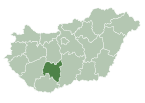Bonyhád: Difference between revisions
remove {{Cleanup|date=February 2008}} |
|||
| Line 38: | Line 38: | ||
==Populations== |
==Populations== |
||
The town's ethnic composition includes [[Hungarians]], [[Germans]], [[Szekely]] and [[Roma_(Romani_subgroup)|Roma]]. In the years leading to [[World War II]], Bonyhád had a sizable Jewish population. In 1941, [[Jews]] constituted approximately 14% of the total population. The community was divided between [[Orthodox Judaism|Orthodox]] and [[ |
The town's ethnic composition includes [[Hungarians]], [[Germans]], [[Szekely]] and [[Roma_(Romani_subgroup)|Roma]]. In the years leading to [[World War II]], Bonyhád had a sizable Jewish population. In 1941, [[Jews]] constituted approximately 14% of the total population. The community was divided between [[Orthodox Judaism|Orthodox]] and [[Neolog |Neolog Judaism]] traditions and Aaron Pressburger was the chief Orthodox rabbi. After the occupation of [[Hungary]] by the German army in March 1944, Jews were isolated and their property was confiscated by the Hungarian authorities. In May 1944, the Jewish population was estimated at around 1,300. In June 1944, the Jewish communities of Bonyhád and surrounding villages were moved to the two ghettos in Bonyhád. Some Jews were severely tortured to find out where they may have placed valuables. In July 1944 those in the ghettos were transported by train to the nearby city Pécs and from there deported to [[Auschwitz]].<ref>János Eisner: A BONYHADI ZSIDOK TORTENETE (The story of Bonyhád's Jews) in Hungarian - Tel-Aviv, 1965) </ref><ref>Leslie Blau: Bonyhád - A Destroyed Community - New York, 1994</ref><ref>Blau László: BONYHÁD - EGY ELPUSZTÍITOTT ZSIDÓ KÖZÖSSÉG (Bonyhád - A Destroyed Jewish Community) in Hungarian - Bonyhád, 2008</ref><ref>http://www.jewishvirtuallibrary.org/jsource/judaica/ejud_0002_0004_0_03315.html</ref> |
||
Some feel that in October 1944, approximately 1,200 Jewish labor servicemen were massacred by the SS in Bonyhád. This is yet to be substantiated. |
|||
after the war a few survivors made an effort to reestablish in Bonyhád the two Jewish communities. After the the 1956 revolt most of Bonyhád's Jews escaped from Hungary - mainly to America and Israel. By 1963 there were only 4 Jewish families left in the town. Bonyhád's last Jewish resident, Mrs. Sári Warum, died in Spring 2013. |
|||
==Facilities== |
==Facilities== |
||
Revision as of 20:54, 8 June 2013
Bonyhád | |
|---|---|
|
Coat of arms of Bonyhád Coat of arms | |
| Country | |
| County | Tolna |
| Area | |
| • Total | 72.14 km2 (27.85 sq mi) |
| Population (2004) | |
| • Total | 14,093 |
| • Density | 195.35/km2 (506.0/sq mi) |
| Time zone | UTC+1 (CET) |
| • Summer (DST) | UTC+2 (CEST) |
| Postal code | 7150 |
| Area code | 74 |
| Website | http://www.bonyhad.hu/ |
Bonyhád is a town in Tolna County in Southwestern Hungary.
Government
It is governed by a city council and a mayor. The current mayor of Bonyhád is Arpad Potapi who has served in this capacity since 2002.
Populations
The town's ethnic composition includes Hungarians, Germans, Szekely and Roma. In the years leading to World War II, Bonyhád had a sizable Jewish population. In 1941, Jews constituted approximately 14% of the total population. The community was divided between Orthodox and Neolog Judaism traditions and Aaron Pressburger was the chief Orthodox rabbi. After the occupation of Hungary by the German army in March 1944, Jews were isolated and their property was confiscated by the Hungarian authorities. In May 1944, the Jewish population was estimated at around 1,300. In June 1944, the Jewish communities of Bonyhád and surrounding villages were moved to the two ghettos in Bonyhád. Some Jews were severely tortured to find out where they may have placed valuables. In July 1944 those in the ghettos were transported by train to the nearby city Pécs and from there deported to Auschwitz.[1][2][3][4]
Some feel that in October 1944, approximately 1,200 Jewish labor servicemen were massacred by the SS in Bonyhád. This is yet to be substantiated.
after the war a few survivors made an effort to reestablish in Bonyhád the two Jewish communities. After the the 1956 revolt most of Bonyhád's Jews escaped from Hungary - mainly to America and Israel. By 1963 there were only 4 Jewish families left in the town. Bonyhád's last Jewish resident, Mrs. Sári Warum, died in Spring 2013.
Facilities
Bonyhád is home to the Völgység Museum. The town's population is served by a Roman Catholic church and a Lutheran church. The remains of the town's two Synagogues are still visible. Various sporting facilities and three high school/college compounds along with the City Hospital currently serve the residents. Telephone service is provided by Bonicom Kft. Gas service is provided by Futomu Kft and water by Vizmu Reszleg.[5]
References
- ^ János Eisner: A BONYHADI ZSIDOK TORTENETE (The story of Bonyhád's Jews) in Hungarian - Tel-Aviv, 1965)
- ^ Leslie Blau: Bonyhád - A Destroyed Community - New York, 1994
- ^ Blau László: BONYHÁD - EGY ELPUSZTÍITOTT ZSIDÓ KÖZÖSSÉG (Bonyhád - A Destroyed Jewish Community) in Hungarian - Bonyhád, 2008
- ^ http://www.jewishvirtuallibrary.org/jsource/judaica/ejud_0002_0004_0_03315.html
- ^ http://www.bonyhad.hu/index.php?akt_menu=435


